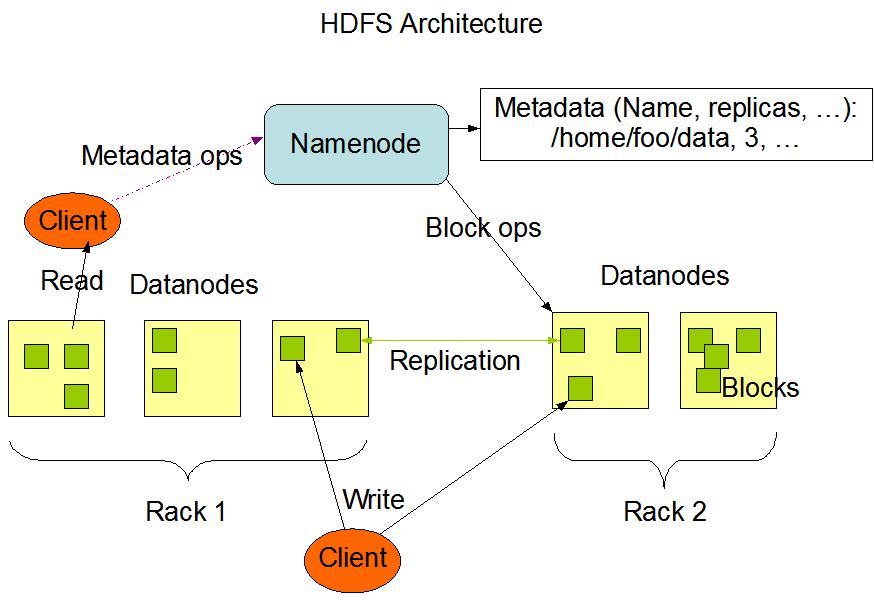What is HDFS?
Whenever it comes to storing and processing large datasets, your discussion starts with Hadoop. So Hadoop is referred to as an open-source framework that is used to efficiently store and process huge datasets that may range in size from gigabytes to petabytes of data. With Hadoop, you don’t need to maintain one large computer for storing and processing data, as it allows clustering multiple computers to perform analysis of huge datasets parallelly and quickly.
Hadoop comprises of four modules namely:
- HDFS or Hadoop Distributed File System – It is a distributed file system that runs on standard hardware.
- YARN or Yet Another Resource Negotiator – It manages and controls cluster nodes and resource usage. Its main function is to schedule jobs and tasks.
- MapReduce – It is a framework that allows programs to do parallel computing on data.
- Hadoop Common – It provides common libraries of Java that can be used across all the modules.
To achieve certification in Hadoop, you need to master the concepts of HDFS and YARN. In this article, we will discuss HDFS, the first component of the Hadoop framework. This will let you know how important it is to upgrade yourself and move ahead in your career by taking up an online Big Data course and achieve Big Data Hadoop Certification.
What is HDFS?
HDFS is an acronym for Hadoop Distributed File System. As the term itself implies, HDFS is a distributed file system that allows the storage of multiple files and their retrieval at the same time at an extraordinary speed. It forms one of the basic components of the Hadoop framework.
HDFS Architecture
The storage system of the Hadoop framework, HDFS is a distributed file system that is capable of running conveniently on commodity hardware to process unstructured data. It is this functionality of HDFS, that makes it highly fault-tolerant. In this architecture, the same data is stored in multiple locations so that if one storage location fails to provide the required data, the same data is easily fetched from other locations. It came into existence with the Apache Nutch project, and today it has become a top-level Apache Hadoop project.
At present, HDFS forms an integral component of Hadoop, along with Hadoop MapReduce, Hadoop YARN, and Hadoop Common.
In the era of Big Data, HDFS constitutes a highly reliable and scalable storage system for Hadoop. It works closely with Hadoop YARN in order to perform data processing and data analytics. This makes it capable of improving the data management layer of the Hadoop cluster, eventually making it efficient for concurrent big data processing. Additionally, HDFS works in close co-ordination with HBase. The above table shows you the key features of HDFS that make it a versatile technology.
Some key techniques that are included in HDFS are;
- In HDFS, servers are completely connected, and the communication takes place through protocols that are TCP-based.
- Even though it is designed for massive databases, normal file systems such as NTFS, FAT, etc. can also be viewed or accessed.
- The checkpoint node allows you to obtain the current status of a node.
The architecture of HDFS is based on master-slave data architecture. Each cluster consists of a single Namenode that functions as a master server so as to manage the file system namespace and give the right access to the right clients.
Then comes the Datanode in the HDFS cluster which is usually one per node in the cluster. The main function of the Datanode is to manage the storage attached to the node that it runs on. Additionally, HDFS includes a file system namespace which is usually executed by a Namenode for performing common operations like opening file, closing, and renaming, and even for directories. The task of Namenode also includes mapping the blocks to Datanodes.

Datanode and Namenode are nothing but Java programming codes that can be executed extensively on commodity hardware machines. The entire HDFS is based on Java programming language. The HDFS platform follows a hierarchical file system strictly. Data replication forms an essential part of the HDFS format.
The scope of HDFS
Instead of considering HDFS as a database, you can refer to it as a data warehouse. It makes the data available by mapping and reducing functions. The data adhere to a robust and simple coherent model. It forms one of the core components of Hadoop. So, if you master this technology, you can definitely be a preferred choice for recruiters when you move into this domain.
Career Prospects
HDFS has become crucial in the IT world because it is the most reliable storage system that exists in Hadoop. If you become an expert in leveraging this technology, you can become an invaluable asset for your company. The average annual salary of a Hadoop developer according to ziprecruiter.com is $107,000. The average annual salary of a senior Hadoop developer is found to be $131,000.
The whopping salary is enough to make you realize that how excellent are the career prospects in this domain. If you really wish to make a career in Hadoop development, you need to master the concepts of HDFS, along with other components like YARN and Hadoop Common, etc.
Conclusion
We are living in the era of Big Data today. There are terabytes and petabytes of data generated every day. So the technologies that are related to Big Data are obviously here to stay. You can opt for a making a career in Hadoop development if you wish to upgrade your career and give it a swift move.
For this, you need to achieve the certification in Hadoop Development. To pass the certification exam, it is strongly recommended that you take up an online training course so as to make your preparation hassle-free. Most of the training providers keep you free of your learning pace and also give you options of learning modes as per your interest and requirements.
So, when are you getting yourself registered to an online training program; to move up in your career.




